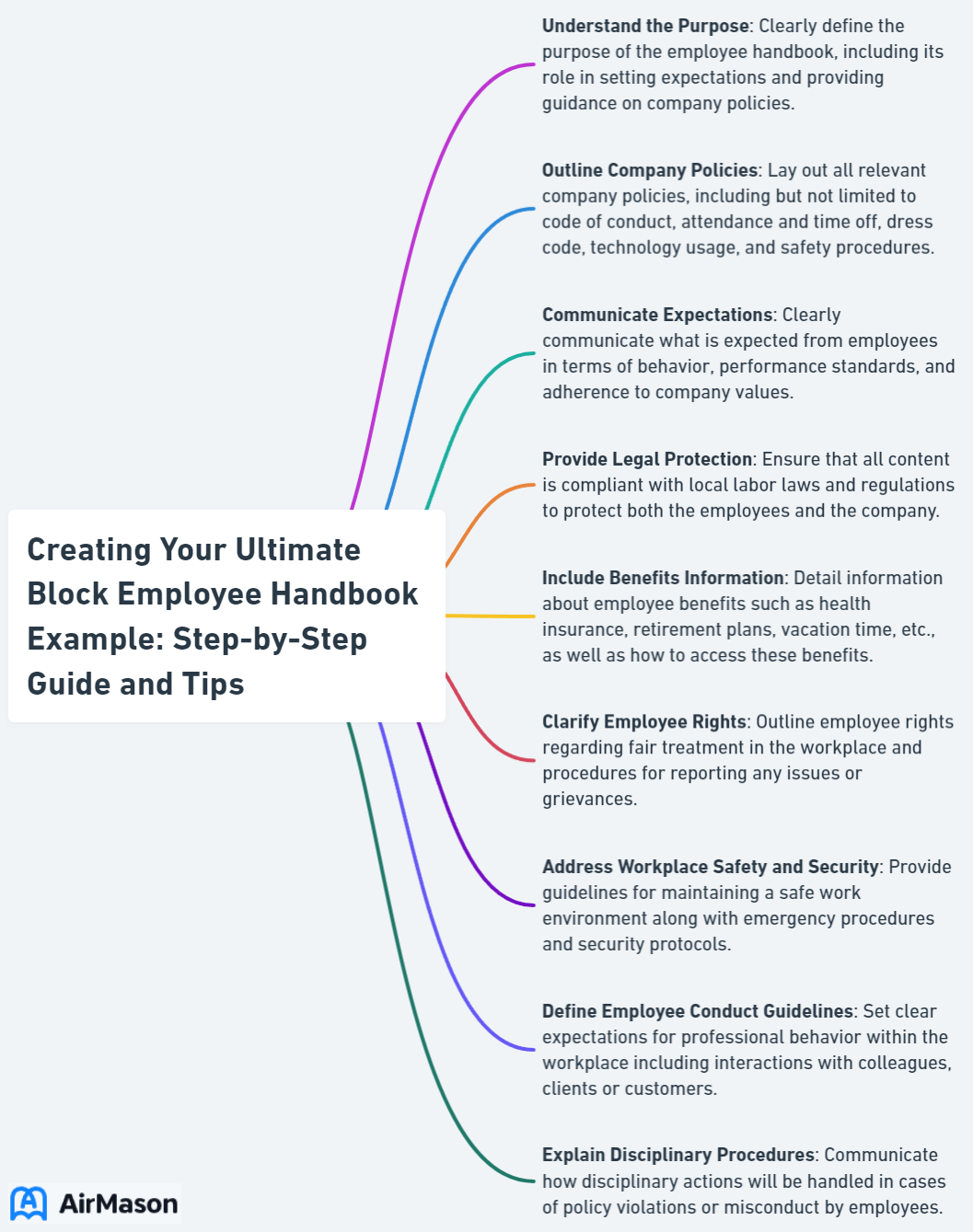
-Drafting a block employee handbook example? This concise guide delivers key insights into constructing a manual that embodies your company’s culture and adheres to legal requisites. With pragmatic steps and standout examples, you’ll have all the resources needed to develop a handbook that effectively guides your employees.
Key Takeaways
- Employees handbooks are essential documents outlining company policies, procedures, and expectations, and should be legally compliant, reflect the company’s brand identity, and be visually appealing for better engagement and comprehension.
- Regular updates and maintenance of the handbook are necessary to reflect changes in company policies and regulations, and employees should be efficiently informed about any updates to ensure understanding and compliance.
- Incorporating the employee handbook into the onboarding process and engaging employees with clear communication can help foster a thorough understanding of company culture, values, and expectations, thereby supporting employee integration and adherence to company standards.
Fortune 100 Company Employee Handbook
Welcome to the comprehensive guide that is the Fortune 100 Company Employee Handbook. This handbook serves as a pivotal resource, outlining the policies, procedures, and expectations that define our workplace culture. Within the pages of the Fortune 100 Company Employee Handbook, you will find valuable information about your rights and responsibilities, code of conduct, benefits, and the core values that shape our organization. It is designed to be your go-to reference for navigating your professional journey within our esteemed Fortune 100 company. Make sure to familiarize yourself with the contents of this handbook to ensure a successful and harmonious experience as a valued member of our dynamic workforce.
Crafting a Block Employee Handbook: What It Entails
An employee handbook, often referred to as an employee manual or a company handbook, serves as a comprehensive guide that outlines company policies, procedures, and expectations, thus providing employees with a clear reference for understanding their roles and responsibilities. The handbook’s contents typically fall into three categories: general information, cultural information, and case-specific information. The depth and breadth of these categories are shaped by factors such as company size, industry, location, and culture.
Creating an employee handbook that truly reflects your company’s brand involves more than just slapping your logo onto a document. It’s about weaving your brand into every aspect of the handbook. This might involve incorporating a company logo, watermark, or custom headers and footers to maintain a unified visual identity. To ensure the handbook is legally compliant and easy to navigate, it’s crucial to conduct a thorough review with an employment lawyer, perform a copy edit for clarity, proofread for typographical errors, and create a table of contents.
Anatomy of an Exemplary Block Employee Handbook
An exemplary employee handbook is more than a collection of rules; it’s a strategic tool that communicates your company’s culture, policies, and legal obligations. It’s a document that reminds employees of their responsibilities and rights, ensuring they have a clear understanding of their role within the organization.
We’ll now examine the structure of a great employee handbook, using an employee handbook builder and an employee handbook template as helpful tools to write an employee handbook.

Company Culture and Core Values
Company culture and core values are the heart and soul of your organization. They set the tone for how your company operates and how employees are expected to behave. When these are clearly articulated in the handbook, it helps establish the same rules and expectations for all employees, promoting a fair and consistent work environment.
Handbooks vary greatly. Some companies transform their culture and values sections from mere words on a page into compelling statements that resonate with employees. For instance, consider a company that includes a comprehensive policy on sexual harassment, explicitly outlining its commitment to maintaining a safe and respectful work environment and detailing the procedures for reporting and addressing incidents. This not only communicates the company’s stance on a critical issue but also demonstrates its commitment to its core values.
Comprehensive Employment Policies
While company culture and values lay the foundation, comprehensive employment policies build the structure of your employee handbook. These policies cover everything from overtime eligibility to standards of conduct, providing employees with a thorough understanding of their rights and obligations.
A comprehensive handbook not only sets clear expectations but also offers protection for the company. By incorporating an at-will policy, for instance, the company explicitly outlines its authority to terminate employment on lawful grounds, thereby providing legal protection in the event of an employee alleging unfair dismissal upon termination. Operational policies such as payroll, timekeeping, and scheduling are also crucial to provide employees with information about the practical aspects of their daily work, thereby contributing to clarity and productivity.
Legal Compliance and Employee Rights
In the world of business, ignorance of the law is no excuse. The same applies to employee handbooks. Ensuring your handbook complies with all relevant laws, such as the Fair Labor Standards Act (FLSA), the Occupational Safety and Health Act (OSH Act), and the Family and Medical Leave Act (FMLA), is vital. Including grievance procedures in your handbook can help address any concerns or disputes that may arise.
Legal compliance isn’t just about avoiding lawsuits and fines. It’s also about safeguarding your company’s reputation. By demonstrating that your company operates within the boundaries of the law, you build trust with your employees, customers, and the public at large.
Now let’s move on to the design aspect of your handbook.
Designing Your Block Employee Handbook

A well-written employee handbook is only half the battle. The design is equally important. A visually appealing, easy-to-read handbook not only captures attention but also enhances comprehension and retention of the information.
We will now examine ways to create a handbook that is both informative and engaging.
Selecting the Right Template
A good template is like a blueprint—it guides your design process, ensuring consistency and coherence throughout the handbook. When selecting a template, consider factors such as the layout, customization options, and whether it includes sections on company values and onboarding.
But remember, a template is just a starting point. To truly reflect your brand, you’ll need to customize it. This might involve adding your company’s logo, incorporating your brand colors and fonts, and tweaking the layout to suit your content. While a pre-made template can save time, it may not fully align with your company’s unique culture and could require significant customization.
Visual Elements That Speak Volumes
While the content of your handbook is certainly important, the visual elements are what draw people in. A well-chosen color scheme can evoke specific emotions and moods, enhancing the impact of your handbook. Similarly, creative fonts can infuse personality and contribute to the overall tone of the handbook, ultimately increasing reader engagement.
Visual elements such as:
- icons
- images
- tables
- illustrations
- graphs
- charts
can also enhance readability, making the information more digestible and engaging for the reader. But be careful not to overwhelm your reader with too many visual elements or large blocks of text, as this can be off-putting and lead to a loss of interest.
Accessibility and Distribution
Once your handbook is designed and ready, it’s time to get it into the hands of your employees. This is where accessibility and distribution come in. Some methods for distributing your handbook include:
- Email: Send the handbook as an attachment or provide a link to download it.
- Intranet postings: Upload the handbook to your company’s intranet for easy access.
- Printed copies: If your employees prefer physical copies, consider printing and distributing the handbook.
Using these methods will help ensure that your handbook reaches all your employees, including those in remote locations.
However, accessibility is about more than just distribution. It’s also about ensuring that your handbook is compatible with different devices and is accessible to individuals with disabilities. This might involve optimizing the handbook for mobile use, providing alternative formats and translations, and including alt text for images for screen-reader compatibility.
Adobe Employee Handbook Example
In this illustrative Adobe Employee Handbook Example, we delve into the comprehensive guidelines and policies that govern the conduct and expectations of individuals within the company. The Adobe Employee Handbook exemplifies a commitment to fostering a positive work environment, outlining protocols for professional behavior, collaboration, and adherence to company values. Through this handbook, Adobe emphasizes its dedication to creating an inclusive workplace, providing employees with the necessary resources to thrive in their roles. This exemplar document serves as a valuable reference, offering insights into Adobe’s corporate culture and promoting a shared understanding of the principles that drive the organization forward.
Real-World Block Employee Handbook Examples

Sometimes, the best way to learn is by example. Companies like 22Squared and Pronto Marketing have crafted noteworthy employee handbooks that we can learn from. For instance, 22Squared’s handbook was authored by a new employee, chronicling their first 22 days at the organization. This unique approach fosters employee engagement and a feeling of inclusion. Furthermore, the handbook underscores the significance of company culture as a potent instrument for success.
Pronto Marketing, on the other hand, has designed a handbook that is easy to read, visually appealing, and well-organized. The handbook features a table outlining group health insurance, providing employees with a clear understanding of their benefits. These examples illustrate how a well-crafted handbook can effectively communicate company culture, policies, and benefits.
Updating and Maintaining Your Handbook

Creating an employee handbook isn’t a one-and-done task. It’s a living document that needs to be updated and maintained regularly to stay relevant and effective.
We’ll now delve into the best practices for maintaining an up to date and compliant handbook.
Review Schedule and Process
Your handbook should undergo a review at least annually to stay current with any changes in company policies or regulations. Establishing a review process is equally important. This involves:
- Reviewing the handbook for clarity and comprehensiveness
- Establishing a regular review schedule
- Checking for applicable information and relevant laws
- Seeking feedback from employees
Additionally, it’s crucial to be aware of the factors that may necessitate updates, such as modifications in company policies, regulations, or societal changes impacting the company’s operations and policy requirements.
Communicating Updates to Team Members
Relaying updates to your team holds equal importance to making the updates. After all, an updated handbook is only useful if your employees are aware of the changes. A multi-channel approach works best, combining:
- Team meetings
- Intranet posts
- Physical signage or bulletin boards
Effective communication also involves ensuring that employees understand the changes and their impact. Managers play a pivotal role in this process, disseminating information about specific policy changes and ensuring that employees comprehend how these changes affect their daily duties and obligations.
Archiving Past Versions
Preserving past versions of your handbook is an integral part of the revision and update process. It’s important for reference and legal compliance purposes and can also serve as a historical record of your company’s policies and procedures.
When archiving past versions of your handbook, it’s important to:
- Maintain version control
- Provide access to the handbooks in electronic or hard copy formats
- Diligently track and document revisions
- Categorize and organize the archived handbooks for easy access, which can be accomplished by creating a comprehensive table of contents and effectively grouping content.
Implementing the Employee Handbook in Onboarding
The onboarding process is a critical time for new hires. It’s their first introduction to the company and its culture, and your employee handbook can be a vital tool in this process. The handbook offers new hires:
- A comprehensive understanding of the company’s vision, values, culture, and policies
- Aid in their assimilation into the company culture
- Provide clarity on their expected responsibilities
Merely handing new hires a copy of the handbook and expecting them to read it is insufficient. Instead, the handbook should be incorporated into the onboarding process, with key policies and procedures explained and discussed. This ensures that new hires fully understand what’s expected of them and have the opportunity to ask questions and seek clarification.
Maximizing Employee Engagement with the Handbook
Employee engagement is integral to the success of any company, with your employee handbook playing a crucial role in nurturing engagement. By actively communicating the organization’s vision, values, and culture, showcasing the company culture, establishing transparency, keeping the team informed, and seeking feedback on the handbook design and content, you can drive employee engagement.
Digital and interactive tools, such as company equipment, can also enhance engagement. For instance, employee engagement software can track new hire progress through the handbook, providing valuable insights into areas that may need further clarification or attention.
Effective management can further foster engagement by facilitating effective communication and nurturing personal relationships within the team.
Crafting an Effective Conclusion for Your Handbook
The conclusion of your handbook is your last chance to leave an impression on your readers. It’s an opportunity to reiterate key points, remind employees of their responsibilities, and emphasize the importance of the policies and procedures outlined in the handbook.
An effective conclusion to your handbook involves:
- Clear and professional language
- Ensuring all employees have the chance to review its contents
- Including an acknowledgment section, where employees can confirm their understanding of the handbook’s content.
Summary
Crafting an effective employee handbook is a significant undertaking, but it’s well worth the effort. A well-designed, comprehensive, and up-to-date handbook not only sets clear expectations for your employees but also serves as a valuable tool for onboarding, engagement, and legal compliance. Whether you’re creating a handbook from scratch or updating an existing one, remember that your handbook is a reflection of your company’s culture, values, and brand. Make it count.
Synchrony Financial Employee Handbook Example
In this illustrative Synchrony Financial Employee Handbook Example, employees gain valuable insights into the organization’s guiding principles and policies. This comprehensive guide outlines the company’s commitment to fostering a positive work environment, emphasizing employee well-being, and promoting a culture of inclusivity. From detailed code of conduct to essential HR procedures, the Synchrony Financial Employee Handbook Example serves as a vital resource, ensuring clarity and alignment with the company’s values. Explore the contents of this handbook to familiarize yourself with the expectations and support mechanisms in place, contributing to a harmonious and productive workplace.
Frequently Asked Questions
Why is an employee handbook important?
An employee handbook is important because it serves as a comprehensive guide for employees to understand company policies, procedures, and expectations, while also aiding in onboarding, engagement, and legal compliance.
What should an employee handbook include?
An employee handbook should include sections on company culture and core values, comprehensive employment policies, and legal compliance. Additionally, it should be visually appealing, easy to read, and easily accessible to all employees.
How often should I update my employee handbook?
You should review and update your employee handbook at least once a year to keep it up to date with any changes in company policies or regulations. This ensures that your handbook remains compliant and relevant.
How can I ensure that my employees are engaged with the handbook?
To ensure employee engagement with the handbook, focus on creating, updating, and promoting the handbook to effectively communicate the organization’s vision, values, and culture. Additionally, regularly seeking feedback from employees on the design and content can drive engagement.
How should I conclude my employee handbook?
Conclude your employee handbook by summarizing key points, reminding employees of their responsibilities, and emphasizing the importance of the policies outlined. Consider including an acknowledgment section for employees to confirm their understanding.
Important Disclaimer:
The article presented here does not serve as a representation of the company’s actual employee handbook mentioned in this article.
Our discussions and insights regarding employee handbook are based on assumptions about what may be considered significant in the companies’ policies. These assumptions are drawn from available information and industry knowledge. Readers are advised that the content provided is for informational purposes only and should not be construed as an exact reflection of any company’s official policies or procedures. For precise and accurate details regarding a company’s employee handbook, individuals should refer directly to the company’s official documentation or consult with appropriate representatives.
Please be aware that the content on this page has been generated by using artificial intelligence language models and may contain errors, inconsistencies, or outdated information. It is provided as-is without any warranties or guarantees of accuracy. We strongly recommend using this content as a starting point for further research. We disclaim any liability for damages or losses resulting from the use or reliance on this content.